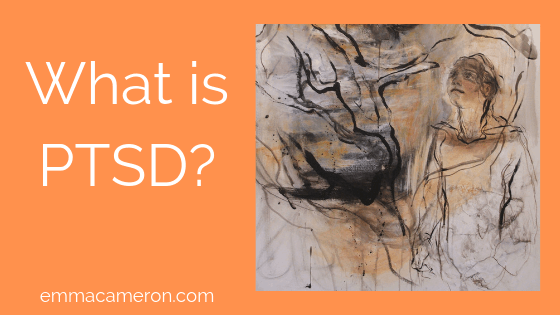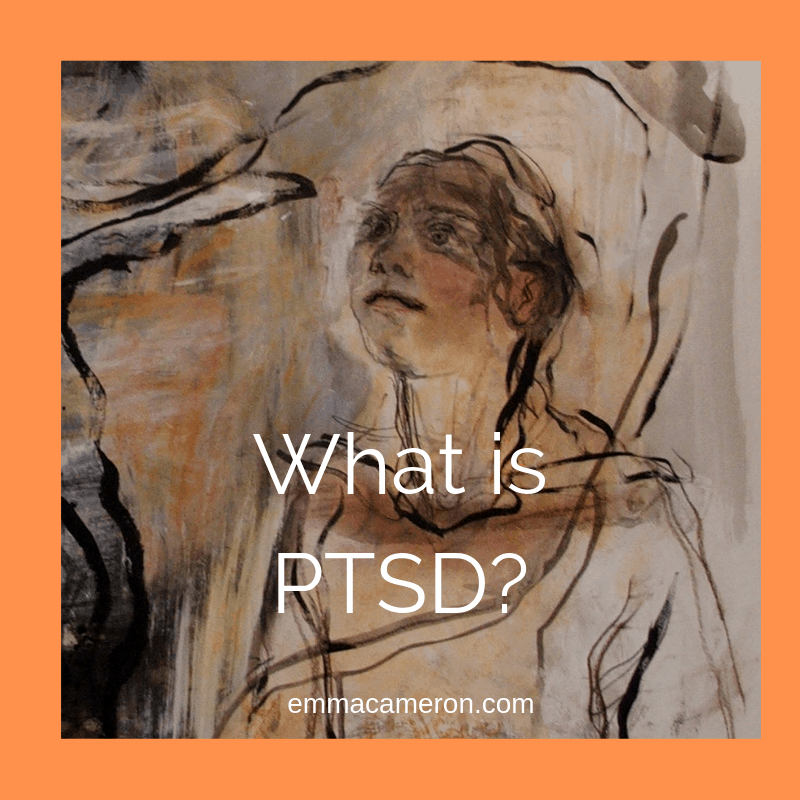
PTSD stands for Post-Traumatic Stress Disorder. It begins after you’ve experienced something traumatic and shocking. Examples might be things like being attacked, witnessing something terrible happen to someone else, being sexually assaulted, or being in an accident.
It’s normal to feel strongly emotionally affected by a traumatic event. But when that traumatic event sticks with you, in a way that feels entirely negative and overwhelming, for long afterwards (more than three or four months) you could have PTSD.
And What is Complex PTSD?
There’s also a kind of PTSD which is called Complex PTSD, or C-PTSD. This is where the trauma was repeated in an ongoing way over time, in the context of an attachment relationship (it’s sometimes called “Relational Trauma Response”). For example, growing up in a home where someone was violent, suicidal, abusive, severely mentally unwell, yelling a lot, or drinking too much. Or growing up in a family that was under enormous stress, like poverty, racism, problems with housing, oppression, etc. A parent with untreated PTSD can also (unintentionally) pass on trauma in the form of C-PTSD, to their child.
Complex PTSD can be more difficult to spot, as its effects are more wide-reaching and have become part of someone’s personality, to some extent.
Who Decides What Counts as Traumatic?
Nobody else gets to define what counts as a trauma for you. Each of us is different, with a different history, and each situation is different, and YOU are the one who can know whether an event (or relationship) was traumatic for you.
A single-incident trauma that happens to someone who already has C-PTSD, can lead to more obvious PTSD. On paper, this particular single-incident trauma may not even be a particularly ‘traumatic’ event, but because there’s underlying C-PTSD it can create quite strong symptoms in the person.
(However, in terms of getting a formal PTSD diagnosis, this needs to come from a medical doctor.)
What is PTSD? A simple guide to signs and treatment. Share on X
3 Signs You May Have PTSD
There are three categories of signs that you might have PTSD:
1: Avoidance and Numbing
You might notice yourself avoiding doing things you used to be able to do, and avoiding going to places you used to go. You may also avoid discussing the traumatic event. You may do things that will help you feel emotionally numb, such as compulsive sexual behaviours, over-working, prolonged gaming sessions, frequent Netflix binges, over-exercising, over-spending, or over-using alcohol, foods and substances.
2: Intrusive Memories/ Images
You may suffer from a lot of disturbing dreams and nightmares, and have ‘flashbacks’. Flashbacks are where you feel as if you’re suddenly right back in the time and place where the trauma happened, as if the traumatic event were happening to you all over again, right now.
3: Anxiety and Emotional Problems
In some cases, PTSD can make someone feel (and/or act) suicidal or violent. More commonly, you are more likely to feel one or more of the following:
- Angry or irritable a lot of the time
- Easily startled
- Frequent feelings of guilt and/or shame
- Behaving in destructive or self-destructive ways

Does Trauma Always Lead to PTSD?
Most of the time, trauma doesn’t lead to PTSD. It depends on several factors:
The Situation You Were In, and How You Could Respond
If you experienced a traumatic event but then you were able to run away, move your head and neck freely, and shake or tremble, the movements your body made at the time may have helped protect you from developing PTSD.
Important Note: In trauma our body’s automatic responses for fight/ flight/ freeze/ flop get triggered. This is NOT under your control. If you were raped or sexually assaulted, your body probably went into a freeze state, as part of its natural coping mechanism. You cannot choose how to respond in this sort of situation, because the conscious-choosing part of your brain automatically goes offline.
Who You Were With
Whether you develop PTSD partly depends on who you were with at the time of the traumatic event(s), and whether (and how) they were able to support you. If you were alone – or, importantly, emotionally alone, because the other person/people there were not attuned to you or on your side – you’ll be more liable to develop PTSD.
Your Past
Another factor is to do with the sort of early life experiences you had. If you had a secure attachment – grew up in a family that was lucky enough to be well-enough resourced, stable and (most important of all) able to be fully emotionally present with you – this may help prevent PTSD occurring after traumatic events later in life. Insecurely attached kids have a higher risk of developing PTSD after a traumatic event later in life.
Your Physiology
Are you one of the 10-15% of people who have the wired-in trait of High Sensitivity (HSP) or other sensory issues? If so, you may have been born with a somewhat increased susceptibility to developing C-PTSD. You can find out more about High Sensitivity here. Read more about links between High Sensitivity and C-PTSD here, in an article by therapist Sara Ouimette LMFT.
Processing After the Event
After experiencing a traumatic event, we need to process what happened. For many people, there is an urge to do something. So after a natural disaster like an earthquake or flood, physically helping with practical things like clear-up and rebuilding, can be a huge part of the healing process. Campaigning for a cause that’s related to your trauma, like racial justice, safer roads or stricter gun controls, can be very helpful too. Talking things through with family and friends, and feeling heard and understood, may also help you process what happened. When processing was limited, or it missed what you actually needed, PTSD may be more likely to develop.
How Overwhelming the Event Was
No matter how well supported and resilient you were before/ during/ after the trauma, sometimes a traumatic event may just be too much for your nervous system, and PTSD develops. Don’t compare yourself with others who have suffered something similar (you’ve no idea what’s going on inside them); and above all please don’t shame yourself for your body’s natural reaction. PTSD is sometimes described as ‘a normal response to an abnormal situation’.

3 Types of Therapy for PTSD
There are three types of therapy that are particularly good for treating PTSD. See if you can find a therapist who offers at least one of them, and who can explain how they work in a trauma-focused or trauma-sensitive way.
1. Relational, Trauma-Informed Psychotherapy or Counselling
Therapists* who work successfully in a trauma-informed way are able to work at relational depth, which is particularly important in treating Complex PTSD. They make use of up-to-date findings from neuroscience. They will check in with you frequently to get feedback about how you are feeling in the moment (both emotionally and in your body), using this information, along with their own felt sense and their clinical experience, to help guide the work.
2. EMDR
EMDR stands for ‘Eye Movement Desensitisation and Reprocessing’. With a large number of clinical trials to back it up, EMDR is one of the most effective treatments for PTSD. EMDR is increasingly available on the NHS, as well as privately. EMDR uses a carefully structured 8-phase process which works with past, present and future aspects of traumatic memories which have been stored in the brain and body in problematic ways. Note: Due to coronavirus, I am currently working online only and not offering EMDR online. However, some therapists do practise EMDR online, so look around.
3. Trauma-Focused CBT
There have been many claims about the effectiveness of CBT (Cognitive Behavioural Therapy). Unfortunately, the reality of the way CBT is often delivered (short treatments and less well trained ‘therapists’, many of whom may not have proper psychotherapy training) does not necessarily reflect the type of CBT that was tested in trials (longer length of treatment, with highly experienced and well-trained therapists). In addition, old-style CBT may not be helpful for PTSD.
However, an updated CBT protocol called Trauma-Focused CBT has been developed. When used by well trained professionals who have a good rapport with their clients, and when enough sessions can be offered, there can be very good outcomes. Trauma-Focused CBT can sometimes be accessed via the NHS, and in some areas it may also be available privately.
How Else Can You Support Your Healing?
Alongside therapy, you can support your healing journey through yoga (ideally with a trauma-sensitive yoga teacher), spending time in nature, eating a wide range of fresh nutritious foods, and above all linking up with friends or community activities, where you are alongside other people in enjoyable and/or meaningful projects. Sometimes psychoactive medications can help too, depending on your circumstances and individual physiology, so do check with your GP or psychiatrist about this.
When you start to feel panicky, overwhelmed and in need of grounding, check out my article Ground Yourself: 12 Easy Ways to Get Calmer.

Can PTSD Be Cured?
The good news is that effective treatment for PTSD is available. Whilst we can never change what happened to you, it’s likely that you can find ways to help change what the trauma means for your sense of self, and how you feel in your body. Effective treatment can help you feel more grounded and calmer, and support you to be able to behave in ways that are in line with your values and goals.
What’s Your Experience Been?
Have you had successful treatment for PTSD? What worked for you? And if you haven’t yet received treatment, did you find this article helpful? Is there anything else would you want someone to know, if they suspect they may have PTSD? Have you had good PTSD therapy? Do let us know in the comments below!
*Therapists from many modalities work in a relational, trauma-informed way. Particularly good therapy modalities for trauma, especially complex trauma, include Accelerated Experiential Dynamic Psychotherapy (AEDP), Integrative Arts Psychotherapy, Attachment-based psychotherapy, Somatic Experiencing, Sensorimotor Psychotherapy, Equine-Assisted Therapy, Arts Therapies, the Comprehensive Resource Model (CRM), EMDR, and Body Psychotherapy. However, above all use your judgement and your intuition when you meet the therapist. The most important factor in therapy is the quality of the relationship between client and therapist. This means that if you don’t feel that you like and respect the therapist, or if you feel that the therapist doesn’t like or respect you, then the therapy is unlikely to work to heal trauma.
Further Reading/ Resources
Trauma Therapy has Changed – Here’s How
Article: ‘PTSD 101: What You Need to Know’ by Brennan Mallonee
Article: ‘Why You Can’t be in a Rush to Heal Trauma’ by Robyn Brickel
Article: Ground Yourself: 12 Easy Ways to Get Calmer
Website & Community for C-PTSD: Out of the Storm
Book: ‘The Complex PTSD Workbook: A Mind-Body Approach to Regaining Emotional Control and Becoming Whole’ by Arielle Schwartz, PhD
Book: ‘The Body Keeps The Score: Brain, Mind, And Body In The Healing Of Trauma’ by Bessel van der Kolk
Free PDF booklet: ‘What is Complex Trauma? A Resource Guide for Youth’ The National Child Traumatic Stress Network www.NCTSN.org https://www.nctsn.org/resources/what-complex-trauma-resource-guide-youth-and-those-who-care-about-them
Trauma is a disruption of connectedness.’
Deb Dana
I was in therapy for two years before my game of ‘name that feeling’ led to me uncovering my own trauma I had no idea was there. (Seems so obvious in hindsight though!) I’ve not tried EMDR as I’m scared of things I don’t understand, which leads me to — understanding it. I read a brilliant (quite scholarly) book by Daniela Sieff (Understanding and Healing Emotional Trauma) and for me, the book was full of hope — for the first time, I understood the good evolutionary reasons for trauma. And my reaction was just how humans react — some of my ‘troubles’ are the natural result of trauma, rather than them being there because I am singularly inadequate and defective (which was my belief).
Naming the trauma legitimised it for me somehow, too. It wasn’t me ‘just moaning’. I have a kind of C-PTSD. I have flashbacks (small) so regularly I barely noticed them — I thought they were normal. Therapy is hard because you have to feel the trauma again (albeit slowly, safely, with awareness) to process it.
I realised that my trauma was why I had difficulty being vulnerable (vulnerability is a sort of precursor I think — all my emotional trauma happened when I was vulnerable, it’s how it gets let in). Which helped me feel a bit brave (in therapy). The courage to trust is hard. I’m still working on this. But identifying it, and reading around it as much as I can, has built a bit of solid ground around the really hard work (therapy) for me.
And a lot of it for me was EARLY. That’s where you need to get to. What I feel daily now are just reverberations.
That’s my armchair £0.02 worth 🙂
I wish everyone on this hard journey courage.
Thank you so much for generously sharing your experience here!